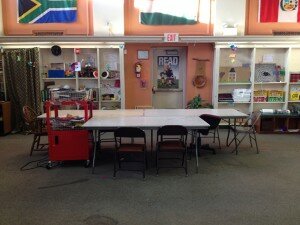A couple of weeks ago, I was catching my breath after a particularly hectic making session. I started to look around the room and consider the space I work in daily. It’s a semi-private room on the library floor, that is shared with the computer lab. There is a half wall that separates the space from the rest of the library, and a door that is always open. It’s secluded enough that there isn’t much adult supervision (aside from myself and sometimes another mentor). As a result participants can do things without embarrassment that they might not do in the completely open part of the library floor, where they have more eyes on them.
The room is open enough that it can be very difficult for me to control who is coming in and out of the space. This complicates things if I have to ask a participant to leave. A closed door may sound like a silly obstacle, but I think it plays a significant psychological roll in creating a feeling of separation between spaces.
While doing the visual sweep, my eyes locked on a table towards the back of the room that was slightly separated from the other two tables I use for programming. This table had become the epicenter for disruptive hangouts, mess making, and the squirreling away of materials. There is a unique dynamic at Lillian Marrero, and the maker program had become a bit of a social scene for the kids. A group of regulars had started congregating at the table to hangout, do homework, and chat. In theory this is great. I love that they feel it is a safe and comfortable space for them to spend time in. The issue was that these hangouts would often devolve into conflict or inappropriate behavior. The activity at that table would inevitably divert my attention from facilitating activities for those who did want to participate more actively. The table was just far enough out of my line of sight that kids could grab materials to “play” without me noticing, stash things in odd places, and take-off without cleaning up.
As I considered how all of this activity was centered around the particular table, I thought, why not just move it? That thought was immediately followed by, why didn’t I think to do this before?
I situated all three tables in the space to form a little island in the center, and rearranged the minimal storage I have for materials, so that it would be to at my side while I was working in the space, instead of behind me. I left that night feeling good about the change, and wondering if it would really have an effect.
From the first day of the new arrangement, it was obvious that there was a big change. Now I can keep an eye on the use of materials, any brewing conflict, and general participant interactions in a way that I couldn’t before. Surprisingly, physically moving that table to a different part of the space has done more to change the behavioral issues I encounter on a daily basis, than anything else I’ve tried.
As an educator, I am continuously exploring how to mediate various factors to create the most positive, respectful, and creatively liberating environment I can. I do a lot of watching and listening, and have tried a variety of different techniques to curb conflict and other issues. Sometimes even when you’re actively looking for innovations, you can get so wrapped up in the status-quo that you overlook the simple solutions. This reminded me to pick my head up and look around every once in a while.


Nice! I’ve been thinking a lot about discipline lately and figured becoming stricter would end any enthusiasm for the program. Who wants to attend School Part II, right?
However, this is a clever way to remain in control without being obvious. Good work, Sari!
For the record, this is works pretty well, too: http://tvtropes.org/pmwiki/pmwiki.php/Main/DisapprovingLook